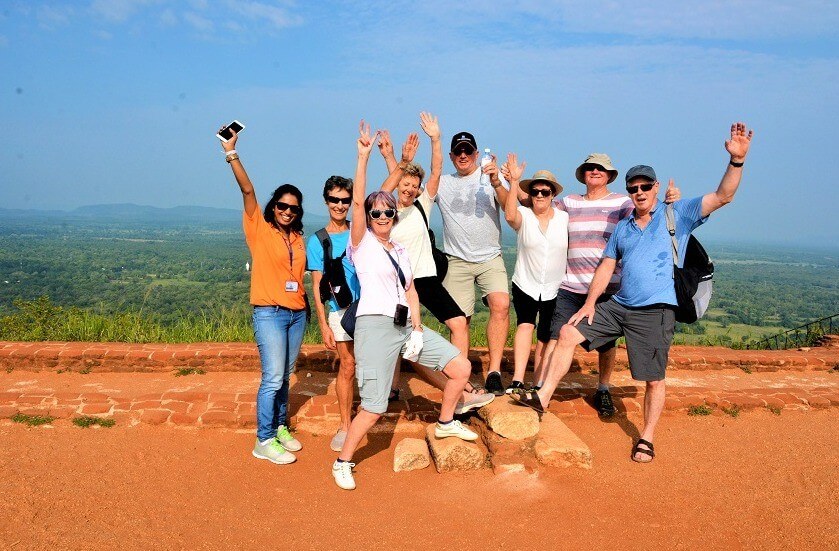Small group tours for seniors represent a burgeoning sector within the travel industry, catering to the specific needs and desires of an increasingly active and adventurous older demographic. These tours offer a unique blend of structured itineraries and personalized experiences, addressing common concerns about accessibility, safety, and social interaction while maximizing enjoyment and enriching travel experiences. This guide delves into the planning, marketing, and operational aspects of creating successful small group tours specifically designed for seniors.
We will explore the key demographic characteristics of this target audience, highlighting their preferred travel styles and destinations. Furthermore, we will examine the critical elements of tour design, including accessibility features, engaging activities, and the crucial role of experienced guides. The discussion will also cover practical considerations such as pre-trip communication, transportation options, accommodation choices, and strategies for managing potential challenges. Ultimately, this guide aims to provide a holistic understanding of the business of crafting exceptional travel experiences for senior travelers.
Understanding the Senior Travel Market
The senior travel market is a significant and growing segment of the tourism industry, presenting unique opportunities for tour operators specializing in small group experiences. Understanding the demographics, preferences, and concerns of this demographic is crucial for developing successful and profitable tour packages.
Senior Traveler Demographics
The key demographic for small group senior tours typically includes individuals aged 65 and older, though the “active aging” trend sees many in their 50s and 60s participating as well. This group is often characterized by higher disposable incomes, increased leisure time, and a desire for enriching experiences. Furthermore, there is a growing segment of independent senior travelers, who value the companionship and support of a small group setting without the dependence on family members. Many are empty nesters with fewer family obligations, allowing for extended travel periods.
Popular Destinations for Senior Group Tours
Popular destinations for senior group tours often prioritize accessibility, safety, and cultural richness. European destinations like Italy, France, and the UK consistently rank highly, offering a blend of historical sites, charming towns, and comfortable accommodations. Cruises, particularly river cruises, are another popular choice, offering ease of travel and a variety of onboard amenities. Domestic destinations within the United States, such as national parks, coastal regions, and historic cities, also attract significant numbers of senior travelers seeking both adventure and relaxation. Destinations known for their cultural heritage, mild climates, and well-developed infrastructure are particularly attractive.
Senior Travel Concerns and Preferences
Senior travelers often have specific concerns and preferences that need to be addressed. These include accessibility of accommodations and transportation, the pace of the itinerary, the availability of medical assistance, and the level of physical activity involved. Many prefer slower-paced itineraries with ample time for relaxation and exploration, rather than rushed sightseeing schedules. Clear communication, well-organized logistics, and a supportive group environment are highly valued. Concerns about health and safety are paramount; therefore, tour operators must provide clear and readily available information regarding emergency procedures and insurance options. Furthermore, the inclusion of accessible accommodations and transportation options is vital to ensuring inclusivity.
Successful Marketing Strategies for Senior Travelers
Effective marketing strategies for senior travelers often involve targeted advertising through senior-focused publications, online platforms, and travel agencies specializing in senior travel. Highlighting the benefits of small group travel, such as personalized attention, enhanced safety, and opportunities for social interaction, is crucial. Using clear and concise language, emphasizing ease of travel and accessibility, and showcasing the unique experiences offered are key components of successful marketing campaigns. Testimonials from past participants and high-quality photography and videography showcasing the beauty of the destinations and the comfort of the accommodations can significantly enhance the appeal of tour packages. Collaborations with retirement communities, senior centers, and other organizations serving senior citizens are also effective ways to reach the target audience.
Comparison of Small Group Tours for Seniors
| Tour Type | Activity Level | Focus | Example Itinerary |
|---|---|---|---|
| Adventure Tour | Moderate to High | Outdoor activities, physical challenges | Hiking in national parks, kayaking, wildlife viewing |
| Cultural Tour | Low to Moderate | Historical sites, museums, local traditions | Visiting historical landmarks, attending cultural performances, cooking classes |
| Relaxation Tour | Low | Rest, rejuvenation, spa treatments | Spa days, leisurely sightseeing, comfortable accommodations |
| Combination Tour | Variable | Blends adventure, culture, and relaxation | A mix of active and relaxing activities, catering to diverse interests |
Planning and Logistics
Planning a successful small group tour for seniors requires meticulous attention to detail and a deep understanding of the unique needs and preferences of this demographic. From initial concept to final execution, every stage demands careful consideration to ensure a safe, enjoyable, and memorable experience. This involves a multi-faceted approach encompassing pre-trip communication, transportation arrangements, accommodation choices, and the creation of a well-structured itinerary.
Tour Planning Stages
The process of planning a small group senior tour unfolds in several key stages. First, a detailed itinerary is developed, outlining daily activities, travel times, and potential points of interest. This is followed by securing necessary reservations for transportation, accommodation, and any planned activities or tours. Next, comprehensive pre-trip communication is essential to keep participants informed and address any concerns. This includes sharing detailed itinerary information, packing lists, emergency contact details, and any relevant health or safety guidelines. Finally, ongoing communication throughout the tour itself ensures smooth operation and addresses any unexpected issues. Post-trip feedback collection allows for continuous improvement in future tour offerings.
Pre-Trip Communication and Information Sharing
Effective pre-trip communication is crucial for a positive senior travel experience. A well-structured communication plan should begin well in advance of the trip’s departure. This involves sending regular updates, including detailed itinerary information, accommodation details, and packing lists. Furthermore, providing contact information for the tour leader and emergency services, along with clear instructions on what to do in case of emergencies, is vital. Addressing any specific needs or concerns of individual participants is also crucial to ensure everyone feels comfortable and well-prepared. Consider using a combination of email, phone calls, and potentially a dedicated online platform or app for sharing updates and facilitating communication.
Transportation Options for Senior Travelers
Choosing appropriate transportation is paramount when catering to seniors. Options should prioritize comfort, accessibility, and safety. Private coach transportation offers a comfortable and controlled environment, minimizing the stress of public transport. This allows for scheduled rest stops and reduces the risk of getting lost or encountering physical challenges. For shorter distances or specific excursions, smaller, accessible vans or taxis can be utilized. Crucially, the chosen mode of transportation must accommodate any mobility limitations within the group. Where possible, pre-booking transportation is recommended to secure availability and ensure smooth transitions between locations.
Accommodation Selection for Senior Travelers
Selecting suitable accommodation involves considering several factors beyond simply cost. Accessibility is crucial, ensuring that rooms and common areas are easily navigable for individuals with mobility impairments. This includes features such as ramps, elevators, grab bars, and wide doorways. Comfort is equally important, prioritizing well-lit rooms, comfortable beds, and easily accessible bathroom facilities. Proximity to amenities and attractions can significantly enhance the overall experience, reducing the need for extensive travel. Furthermore, consider choosing hotels with readily available assistance services, such as staff who can provide support with luggage or other needs.
Sample 7-Day Small Group Tour Itinerary: Tuscany, Italy
This itinerary focuses on a 7-day tour of Tuscany, Italy, designed for seniors. The estimated cost per person (excluding international flights) is approximately $3,500, which includes accommodation, transportation, guided tours, and some meals. This is a sample and costs may vary depending on the season and specific choices.
| Day | Activity | Estimated Cost |
|---|---|---|
| 1 | Arrival in Florence, check-in to hotel, leisurely afternoon exploring the city center. | $100 (hotel, dinner) |
| 2 | Guided walking tour of Florence, including the Duomo and Uffizi Gallery. | $150 (guide, entrance fees, lunch) |
| 3 | Day trip to Siena and San Gimignano, enjoying Tuscan cuisine. | $200 (transportation, guide, lunch) |
| 4 | Cooking class focusing on traditional Tuscan dishes, followed by a wine tasting. | $180 (class, ingredients, wine tasting) |
| 5 | Relaxing day in the Tuscan countryside, visiting a local farm and enjoying scenic views. | $120 (transportation, farm visit, lunch) |
| 6 | Visit to a medieval town like Lucca, exploring its historical sites and enjoying free time. | $100 (transportation, lunch) |
| 7 | Departure from Florence. | $50 (transportation to airport) |
Marketing and Promotion
Marketing small group tours for seniors requires a nuanced approach, understanding their specific needs and preferences. Effective marketing hinges on conveying a sense of trust, security, and value, while highlighting the unique benefits of a tailored travel experience. This section outlines strategies for reaching this valuable demographic.
Marketing Materials for Senior Travelers
Brochures and website copy should prioritize clear, concise language and large, easy-to-read fonts. Images should depict active, engaged seniors enjoying themselves in comfortable and accessible settings. Brochures should include detailed itineraries, emphasizing aspects like comfortable accommodations, manageable pacing, and opportunities for relaxation. Website copy should focus on the tour’s unique selling points, addressing potential senior concerns such as accessibility, safety, and health considerations. Testimonials from previous senior travelers add significant credibility. For example, a brochure might feature a large photograph of seniors enjoying a leisurely lunch with a stunning view, alongside a testimonial praising the tour’s comfortable pace and friendly group atmosphere. The website might use a similar image, but also include detailed information about accessibility features in hotels and transportation.
Online and Offline Promotional Channels
Reaching senior travelers effectively requires a multi-channel approach. Online, this includes targeted advertising on websites and social media platforms frequented by seniors, such as AARP’s website or Facebook groups focused on travel and retirement. Search engine optimization (SEO) is crucial for ensuring the tour company’s website appears in relevant search results. Offline channels include partnerships with senior centers, retirement communities, and travel agencies specializing in senior travel. Print advertising in publications targeting seniors, such as retirement magazines or local newspapers with a large senior readership, can also be effective. For example, a targeted Facebook ad campaign might show images of seniors enjoying the tour’s activities, with text emphasizing the tour’s accessibility and focus on relaxation. A partnership with a local senior center could involve offering a presentation about the tour and providing brochures.
Pricing Strategies for Senior-Focused Tours
Several pricing strategies can be employed. Offering senior discounts is a common and effective method, providing an immediate incentive. Alternatively, a tiered pricing structure could offer different levels of service and amenities at varying price points, allowing seniors to choose the option that best suits their budget and preferences. Bundling services, such as including meals or excursions in the overall tour price, can also enhance perceived value. For example, a tour operator might offer a 10% discount for seniors aged 65 and older, or offer a “premium” package that includes private transportation and upgraded accommodations at a higher price point.
Building Trust and Credibility with Senior Clients
Building trust is paramount. This involves transparent communication, clear and detailed information, and readily available customer service. Featuring testimonials and showcasing the expertise and experience of tour guides can significantly enhance credibility. Providing detailed itineraries and emergency contact information instills a sense of security. A strong online presence with positive reviews further strengthens trust. For example, the tour company website might prominently display testimonials from past clients, alongside contact information and emergency protocols. Guarantees and cancellation policies should be clearly stated.
Visual Representation of an Ideal Small Group Tour Experience for Seniors
Imagine a small group of eight seniors, comfortably seated on a spacious, climate-controlled tour bus. They are on their way to a charming, historic town, their laughter and conversation filling the air. The bus arrives at a quaint, easily accessible hotel with comfortable rooms and helpful staff. Throughout the tour, the pace is relaxed and unhurried, with ample time for sightseeing, leisurely meals, and opportunities for rest. Guided walking tours are at a comfortable pace, with frequent rest stops. Excursions are carefully chosen to minimize strenuous activities, focusing instead on cultural experiences and scenic beauty. Evenings are spent enjoying convivial dinners together, sharing stories and forging new friendships. The overall atmosphere is one of warmth, camaraderie, and mutual respect. The tour leader, experienced and knowledgeable, is attentive to the needs of each participant, ensuring everyone feels safe, comfortable, and well-cared for.
End of Discussion
Creating successful small group tours for seniors requires a multifaceted approach that balances meticulous planning with a deep understanding of the target market’s needs and preferences. By focusing on accessibility, engaging activities, experienced guides, and proactive risk management, tour operators can deliver enriching and memorable travel experiences. Careful attention to marketing and communication is also crucial for building trust and attracting this discerning clientele. Ultimately, the success of these tours lies in providing a safe, comfortable, and stimulating environment that allows seniors to explore the world with confidence and joy, creating lasting memories and fostering a sense of community.




